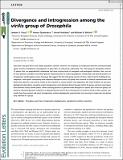Files in this item
Divergence and introgression among the virilis group of Drosophila
Item metadata
| dc.contributor.author | Yusuf, Leeban Hussien | |
| dc.contributor.author | Tyukmaeva, Venera | |
| dc.contributor.author | Hoikkala, Anneli | |
| dc.contributor.author | Ritchie, Michael Gordon | |
| dc.date.accessioned | 2022-11-29T16:30:04Z | |
| dc.date.available | 2022-11-29T16:30:04Z | |
| dc.date.issued | 2022-12-23 | |
| dc.identifier | 281804259 | |
| dc.identifier | a8837fcc-47f6-4e8d-b262-323e9c23ba76 | |
| dc.identifier | 85142895090 | |
| dc.identifier | 85142895090 | |
| dc.identifier | 000892170500001 | |
| dc.identifier.citation | Yusuf , L H , Tyukmaeva , V , Hoikkala , A & Ritchie , M G 2022 , ' Divergence and introgression among the virilis group of Drosophila ' , Evolution Letters , vol. 6 , no. 6 , pp. 537-551 . https://doi.org/10.1002/evl3.301 | en |
| dc.identifier.issn | 2056-3744 | |
| dc.identifier.other | ORCID: /0000-0001-7913-8675/work/124079172 | |
| dc.identifier.uri | https://hdl.handle.net/10023/26516 | |
| dc.description | Funding: Natural Environment Research Council (Grant Number(s): NE/J020818/1) NERC Biomolecular Analysis Facility (Grant Number(s): NBAF852). | en |
| dc.description.abstract | Speciation with gene flow is now widely regarded as common. However, the frequency of introgression between recently diverged species and the evolutionary consequences of gene flow are still poorly understood. The virilis group of Drosophila contains 12 species that are geographically widespread and show varying levels of prezygotic and postzygotic isolation. Here, we use de novo genome assemblies and whole-genome sequencing data to resolve phylogenetic relationships and describe patterns of introgression and divergence across the group. We suggest that the virilis group consists of three, rather than the traditional two, subgroups. Some genes undergoing rapid sequence divergence across the group were involved in chemical communication and desiccation tolerance, and may be related to the evolution of sexual isolation and adaptation. We found evidence of pervasive phylogenetic discordance caused by ancient introgression events between distant lineages within the group, and more recent gene flow between closely related species. When assessing patterns of genome-wide divergence in species pairs across the group, we found no consistent genomic evidence of a disproportionate role for the X chromosome as has been found in other systems. Our results show how ancient and recent introgressions confuse phylogenetic reconstruction, but may play an important role during early radiation of a group. | |
| dc.format.extent | 15 | |
| dc.format.extent | 1280033 | |
| dc.language.iso | eng | |
| dc.relation.ispartof | Evolution Letters | en |
| dc.subject | Divergence | en |
| dc.subject | Gene flow | en |
| dc.subject | Introgression | en |
| dc.subject | Phylogenomics | en |
| dc.subject | Reproductive isolation | en |
| dc.subject | Speciation | en |
| dc.subject | QH301 Biology | en |
| dc.subject | QH426 Genetics | en |
| dc.subject | Ecology, Evolution, Behavior and Systematics | en |
| dc.subject | Genetics | en |
| dc.subject | DAS | en |
| dc.subject | MCC | en |
| dc.subject.lcc | QH301 | en |
| dc.subject.lcc | QH426 | en |
| dc.title | Divergence and introgression among the virilis group of Drosophila | en |
| dc.type | Journal item | en |
| dc.contributor.sponsor | NERC | en |
| dc.contributor.institution | University of St Andrews. School of Biology | en |
| dc.contributor.institution | University of St Andrews. St Andrews Bioinformatics Unit | en |
| dc.contributor.institution | University of St Andrews. Centre for Biological Diversity | en |
| dc.contributor.institution | University of St Andrews. Institute of Behavioural and Neural Sciences | en |
| dc.identifier.doi | https://doi.org/10.1002/evl3.301 | |
| dc.description.status | Peer reviewed | en |
| dc.identifier.grantnumber | NE/J020818/1 | en |
This item appears in the following Collection(s)
Items in the St Andrews Research Repository are protected by copyright, with all rights reserved, unless otherwise indicated.

